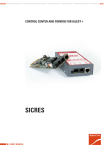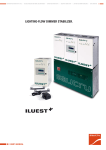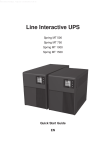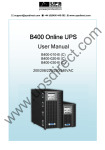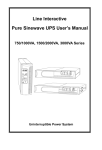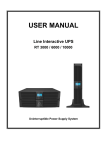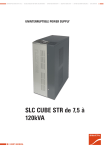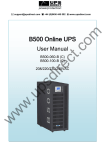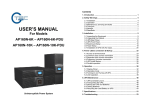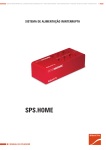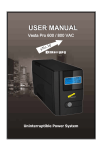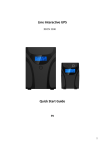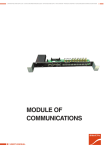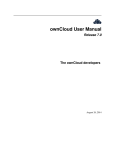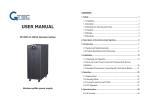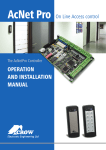Download english
Transcript
U N I N T E R R U P T I B L E P O W E R S U P P LY ( U P S ) + L I G H T I N G F L O W D I M M E R S TA B I L I Z E R S + P O W E R S U P P LY + S TAT I C I N V E R T E R S + P H O T O V O LTA I C I N V E R T E R S + M I C R O T U R B I N E S + V O LTA G E S TA B I L I S E R S UNINTERRUPTIBLE POWER SOURCE SPS ADVANCE Series USER’S MANUAL GENERAL INDEX General index 1.Introduction 6. Maintenance, warranty and service 1.1. Gratefulness letter 6.1. Troubleshooting guide Using this manual 6.1.1. Audible Alarm Trouble Shooting 6.1.2. General Trouble Shooting 1.2. 1.2.1. Used conventions and symbols 1.2.2. For more information and/or help 1.2.3. Safety and first aid 6.2. Battery replacement 2. Quality and standard guarantee 6.2.1. 750 / 1000 VA models 6.2.2. 1500 / 2000 VA models 6.2.3. 3000 VA model 2.1. Management declaration 6.3. 2.2.Standard 2.3.Environment. 3.Description 4. Presentation of system 4.1. Front Panel 4.2. Introducing the LCD display 4.3. Audible alarm introduction 4.4. Back panel Warranty conditions 6.3.1. Covered product 6.3.2. Warranty terms 6.3.3. Out of the scope of supply 6.4. Available maintenance and service contracts 6.5. Technical service network 7.Annexes 7.1.Specification 4.4.1. 750 / 1000 VA models 4.4.2. 1500 / 2000 VA models 4.4.3. 3000 VA model 5.Installation 5.1. Inspecting the Equipment 5.2.Placement 5.3.Charging 5.3.1. Load connection 5.4. Modem / Phoneline Connection 5.5. DC Start function 5.6. Turn On/Off 5.7. UPS Setup 5.7.1. Tower Setup 5.7.2. Rack-Mount Setup 5.8. Emergency Power Off (E.P.O.) set up 5.9. Additional battery installation setup 5.9.1. 1500 / 2000 VA models 5.9.2. 3000 VA model 5.10. Communication Ports 5.10.1. RS232 + Optocouplers 5.10.2. USB port: HID protocol 5.10.3.AS400 interface (Optional). Not available for models lower than 1500 VA 5.11. Software installation SALICRU 3 INTRODUCTION 1. Introduction 1.2.1. Used conventions and symbols «Warning» symbol. Carefully read the indicated paragraph and take the stated prevention meas- 1.1. Gratefulness letter We would like to thank you in advance for the trust you have placed in us by purchasing this product. Read this instruction manual carefully before starting up the equipment and keep it for any possible future consult that can arise. We remain at you entire disposal for any further information or any query you should wish to make. «Danger of electrical discharge» symbol. Pay special attention to it, both in the indication on the equipment and in the paragraph referred to this user’s manual. i «Main protective earthing terminal» symbol. Connect the earth cable coming from the installation to this terminal. «Earth bonding terminal» symbol. Connect the earth cable from the loads or battery cabinet to this terminal. Yours sincerely. SALICRU The equipment here described can cause important physical damages due to wrong handling. This is why, the installation, maintenance and/or fixing of the here described equipment must be done by our staff or specifically authorised. According to our policy of constant evolution, we reserve the right to modify the specifications in part or in whole without forewarning. All reproduction or third party concession of this manual is prohibited without the previous written authorization of our firm. 1.2. Using this manual The target of this manual is to give explanations and procedures for the installation and operating of the equipment. This manual has to be read carefully before installing and operating it. Keep this manual for future consults. This equipment has to be installed by qualified staff and, the simple help of this manual, it can usable by personnel without specific training. 4 ures. i «Notes of information» symbol. Additional topics that complement the basic procedures. Preservation of the environment: The presence of this symbol in the product or in their associated documentation states that, when its useful life is expired, it will not be disposed together with the domestic residuals. In order to avoid possible damages to the environment, separate this product from other residuals and recycle it suitably. The users can contact with their provider or with the pertinent local authorities to be informed on how and where they can take the product to be recycled and/or disposed correctly. 1.2.2. For more information and/or help For more information and/or help of the version of your specific unit, request it to our Service and Technical Support (S.T.S.). 1.2.3. Safety and first aid Together with the equipment and this «User and installation manual», it is provided the information regarding to «Safety instructions» (See document EK266*08). Before proceeding to the installation or commissioning, check that both information are available; otherwise request them. It is obligatory the compliance of the «Safety instructions», being the user the legal responsible regarding to its observance. Once read, keep them for future consults that can arise. USER'S MANUAL QUALITY AND STANDARD GUARANTEE 2. Quality and standard guarantee 2.1. Management declaration Our target is the client’s satisfaction, therefore this Management has decided to establish a Quality and Environmental policy, by means of installation a Quality and Environmental Management System that becomes us capable to comply the requirements demanded by the standard ISO 9001 and ISO 14001 and by our Clients and concerned parts too. 2.3. Environment. Equipment recycling at the end of its useful life: Our company commits to use the services of authorised societies and according to the regulations, in order to treat the recovered product at the end of its useful life (contact your distributor). Packing: To recycle the packing, follow the legal regulations in force. Batteries: The batteries mean a serious danger for health and environment. The disposal of them must be done in accordance with the standards in force. Likewise, the enterprise Management is committed with the development and improvement of the Quality and Environmental Management System, through: • The communication to all the company about the importance of satisfaction both in the client’s requirements and in the legal and regulations • The Quality and Environmental Policy diffusion and the fixation of the Quality and Environment targets. • To carry out revisions by the Management. • To provide the needed resources. 2.2. Standard The SPS ADVANCE product is designed, manufactured and commercialized in accordance with the standard EN ISO 9001 of Quality Assurance. The marking shows the conformity to the EEC Directive (quoted between brackets) by means of the application of the following standards: • 2006/95/EC of Safety of Low Voltage • 2004/108/EC of Electromagnetic Compatibility (EMC). • in accordance with the specifications of the harmonized standards. Standards of reference: • EN 60950-1: Equipment Information Technology. Security. Part 1: General requirements. • IEC/EN 62040-2: Uninterruptible power supplies (UPS). Part 2: Requirements for Electromagnetic Compatibility (EMC). • IEC/EN 62040-3: Uninterruptible power supplies (UPS). Part 3: Methods of operation and specification of test requirements. The declaration of conformity CE of the product is at the disposal of the client previous express request to our head offices. SALICRU 5 DESCRIPTION 3. Description • Features: Microprocessor control guarantees high reliability. High frequency design. This series is a compact and fully pure sinewave line interactive UPS, and it designs for application and environment, such as desktops, servers, workstations, and other networking equipments. This model is available in the output ratings of 750, 1000, 1500, 2000, and 3000VA. This series protects your sensitive electronic equipments against power problems including power sags, spike, brownouts, line noise, and blackouts. This series designs from two-in-one form factor; it can be placed either in Rack 2U or Tower. The front panel of the UPS includes LED indicators and four push buttons (Power Switch, UPS Test/Silence, Configure, and Enter) that allow to monitor easily, configuration and control, AC line-in, notification of site wiring fault and output load status of the UPS. It also includes four LCD bar graphic (Load/Battery Level Indication); two status indications (On AC, On Battery); five alarm indications (Overload, Over Temperature, Site Wiring Fault, Battery Fault, Self Test Failure). A push button from the front panel allows silencing of the AC fail alarm and the initiation of the UPS self test sequence as well. The UPS case for 750 ~ 2000VA is made of plastic as well as 3000VA is made of metal. Built-in boost and buck AVR. User replaceable design for 1500VA or above. Selectable output range and line sensitive. Cold startup capability. Optocouplers/RS-232/USB communication port. SNMP allows for web-based remote or monitoring management. Enable to extend runtime with scalable external battery pack for 1500VA or above. Overload, Short-circuit, and overheat protection. Rack/Tower 2 in 1 Design. 19” rack mount available for all models. This series is powered from the AC mains and supply AC outputs via receptacles on the rear panel. Communication and control to the unit is available through serial or USB ports located on the rear panel. The serial port will support communications directly with a server. The communications protocol for the serial ports shall conform to true RS232 interface.. 6 USER'S MANUAL PRESENTATION OF SYSTEM 4. Presentation of system 4.1. Front Panel The total view of the LCD (in front panel): Fig. 1. The total view of the LCD The primary introduction to above figure: 1. Power Switch ON/OFF. To turn on the UPS, press the “ON/OFF” button more than three seconds. T o turn off the UPS, press and hold this button until you hear the UPS beep ceases.. 2. UPS Test/ Alarm Silence Switch. When AC utility power is available and battery is full charged, it is possible to perform self-test function by pressing and holding the “TEST” button for five seconds. T o disable alarm buzzer, press this button for a second that will turn off the alarm buzzer. Each time a new alarm event is encountered the alarm that will sound and press this button to turn off the alarm. Note: Unable to disable alarm buzzer as below conditions: Low Battery, Overload, Fan Failed, Fan Fault Time Out, Over Temperature. 3. Configure switch: To reconfigure the internal UPS setup options, follow the procedure as below: Step 1: By entering the “CNFG” button more than three seconds, UPS will transfer to “Rated voltage” configure mode. S tep 2: Pressing the “CNFG” button more than one second, the UPS allows you to select the “Rated voltage one by one. S tep 3: After selecting the mode, press the “ENTER” button more than three seconds, the “Rated voltage” is configured. S tep 4: UPS will automatically transfer to “Input type” configure mode. SALICRU S tep 5: Pressing the “CNFG” button more than one second, the UPS will allow you to select the “Input type” one by one. S tep 6: After selecting the mode, press the “ENTER” button more than three seconds, the “Input type” is configured.. 4. Enter switch: Press the «ENTER» button after you choose the mode. 5. Input parameters (voltage & frequency): This part gives the information of the AC utility power, including input voltage and input frequency (autosensing). Fig. 2. The figure indicates that the input voltage is 230V and the input frequency is 50Hz. 6. Auto Voltage Regulation: The LCD symbol indicates that the UPS is in AVR (Auto Voltage Regulation) mode. 7. Line Mode: The LCD symbol illuminates when UPS is on and the AC source is available. 8. Battery. The LCD symbol is in charging mode. indicates that the battery 7 PRESENTATION OF SYSTEM The LCD symbol indicates that the battery is working (the AC source is not available),and it will flicker every second when battery is low. The battery symbol also could show battery level: There are four segments to indicate the amount of battery capacity remaining. The higher the battery capacity, the more indicators that will be illuminated. Each indicator designates a 25% capacity level. Please see the following capacity level respectively. This is: –– 100% to 76% , all of the four indicators illuminate. –– 75% to 51% , three indicators illuminate. –– 50% to 26% , two indicators illuminate. –– 25% to 11% , only one indicator illuminates. –– 10% to 0% , none of the indicator illuminates. When the battery is empty, the symbol flicker every second. will be displayed constantly, and the output voltage is 0Vac 0Hz. Battery missing: If the battery connection is not good, the LCD will display “FAULT CODE 1”. Fan fail: If the fan is locked, The symbol “FAULT CODE 2” will flicker every second; if the time is out. The symbol will be displayed constantly. Over temperature: If the temperature of the UPS is too high, The LCD will display “FAULT CODE 3” constantly. Output invalid: If output voltage is out of range, the LCD will display “FAULT CODE 4” constantly. Battery overcharged: The LCD will display “FAULT CODE 5” constantly. Output short circuit: The LCD will display “FAULT CODE 6” constantly. Other fault type: The LCD will display “FAULT CODE 8” constantly. 13. Input type (Operation mode). 9. Output parameters (voltage & frequency): This part gives the information of the output, including output voltage and output frequency. Fig. 5. Operation mode indication Normal: The UPS accepts a input voltage range of ±20%. Fig. 3. The figure indicates that the output voltage is 230V and the output frequency is 50Hz. 10. Capacity of Load %: The LCD gives the load information by displaying the load percentage. Fig. 4. Generator: The low frequence transfer point changes at 40Hz and there is not limit for the high frequence transfer point. Extended margin: The UPS accepts a input voltage margin of -30% to +20%. 14. Output voltage margin: The UPS output voltage selection: 110Vac / 120Vac / 127Vac o 220Vac / 230Vac / 240Vac. The figure indicates the capacity of Load. Normally, the symbol will not illuminate, but when the load percentage is more than 110% (overload),it will flicker every second. If over load is time out , it will illuminate constantly. 11. Site Fault: The Site Fault indicator will light when UPS is plugged into an improperly utility. This function is only available for 120Vac models 12. Fault code: When UPS fails, the corresponding LCD symbol will illuminate to show the type of failure. Fig. 6. Output voltage margin indication 110Vac/120Vac/127Vac are LV mode (low voltage). 220Vac/230Vac/240Vac are HV mode (high voltage). Example: To a HV UPS, after selection the 230Vac mode (default selection) by the switches “CNFG” and “ENTER”, the output voltage will be approximately 230V, and the LCD display will be how the next figure shows: Battery bad: When the battery of the UPS is bad, the symbol will be displayed constantly. Over load time out: When UPS is Over load time out, the symbol will be displayed constantly. At the same time, the symbol will 8 Fig. 7. Indication after the selection of HV 230 Vac mode. USER'S MANUAL PRESENTATION OF SYSTEM Examples to the LCD display: 4.2. Introducing the LCD display a. If the mains supply exist: ICON b. If the mains supply do not exist: STATUS DESCRIPTION Steady The UPS is operating on mains power Steady UPS is in AVR mode (AVR Auto Voltage Regulation) Steady Battery is in charging mode Steady Battery is in discharging mode Battery capacity: 76% ~ 100% Battery capacity: 51% ~ 75% Battery capacity: 26% ~ 50% Battery capacity: 11% ~ 25% Battery capacity: 0% ~ 10% Flashing UPS is overload Steady UPS is overload and the time is out Steady UPS is overload and the time is out Steady UPS is plugged intro an improperly polarity (only for LV models) Steady Battery bad Code 1 Battery disconnect Code 2 Fan fail Code 3 Over temperature Code 4 Output voltage is out of range Code 5 Battery overcharged Code 6 Output short circuit Code 8 Other fault type Table 1. Display LCD symbols 4.3. Audible alarm introduction Condition Alarm Backup mode (Power Failure) Sounding every four seconds Low Battery Sounding every second UPS fault Continuously Sounding Overload Sounding every second Battery Replacement Sounding every second Table 2. Alarm warning frequency SALICRU 9 PRESENTATION OF SYSTEM 4.4. Back panel 4.4.1. 750 / 1000 VA models 1000-LV Fig. 8. No. 750-LV 1000-HV 750-HV View of the 750 and 1000 VA models Function LV model(110/120/127Vac) HV model(220/230/240Vac) 1 Modem / Network Surge Protection 2 RS232 / Dry-Contact Communication Port 3 USB Communication Port 4 AC Input Power cord AC Input & Protection 5 AC Output NEMA AC Output IEC Table 3. Rear panel description for LV and HV models table 4.4.2. 1500 / 2000 VA models 4.4.2.1. UPS module Fig. 9. 10 Rear panel for HV model Fig. 10. Rear panel for LV model USER'S MANUAL PRESENTATION OF SYSTEM No. Function LV model (110/120/127Vac) HV model (220/230/240Vac) 1 RS232 / Dry-Contact Communication Port 2 SNMP Port or AS400 3 USB Port 4 EPO 5 6 Modem / Network Surge Protection N/A Input Breaker 7 AC Output 8 AC Input 9 External Battery Connector Table 4. Rear panel description for LV and HV models table 4.4.2.2. Battery module Fig. 12. Rear panel for LV model Fig. 11. Rear panel for HV model 4.4.3. 3000 VA model Fig. 14. Rear panel for LV model Fig. 13. Rear panel for HV model No. Function LV model (110/120/127Vac) HV model (220/230/240Vac) 1 Output thermic protection 2 AC Output 3 AC Input 4 Modem / Network Surge Protection 5 Input Breaker N/A 6 Input Power Cord N/A 7 SNMP Slot or AS400 8 External Battery Connector 9 EPO 10 USB Port 11 RS232 / Dry-Contact Communication Port Table 5. Rear panel description for LV and HV models table SALICRU 11 INSTALLATION 5. Installation 5.1. Inspecting the Equipment Inspect the UPS upon receipt. If the UPS has been damaged during shipment, keep the box and packing material for the carrier. Notify the carrier and dealer immediately. 5.2. Placement This UPS should be installed indoors with adequate airflow and free of contamination. Locate it in a clean and indoor environment, free from moisture, flammable liquids, and direct sunlight. Maintain a minimum clearance of 4 inches (100mm); an ambient temperature range must be 0°C to 40°C (32°F to 104°F), and operating humidity range must be 20% to 80% relative humidity (non-condensing).. The long term uses at ambient temperature in higher than 25°C which should reduce battery life. In addition, place the UPS unit away from the monitor at least 20cm. to avoid interference. 5.3. Charging 5.5. DC Start function DC Start Function enables UPS to be started up when AC utility power is not available and battery is full charged. Just simply press the On/Off switch to turn on the UPS. 5.6. Turn On/Off To turn on/off the UPS, you should press the on/off switch three seconds at least. 5.7. UPS Setup All models series are designed for tower and rack purpose. They can be installed as a 19 inch equipment rack, and 3000 VA can be placed in a tower (with optional stand) as well. Please follow the instruction for Tower Setup or RackMount Setup. 5.7.1. Tower Setup This series can be placed in horizontally and vertically. 3000 VA model is designed in a rack itself. As a tower, it is provided with the optional UPS stand to stabilize the UPS when the UPS is positioned in vertically. The UPS stand must be attached to the bottom of the tower. 5.7.1.1. 750 / 1000 VA models This UPS is shipped from the factory with its internal battery fully charged; however, some charge may be lost during shipping. The battery should be recharged prior to use. Plug the UPS into an appropriate power supply and allow the UPS to charge at least 4 hours. 5.3.1. Load connection Connect one load-related device to each of the power receptacles supplied at the rear of the UPS. 5.4. Modem / Phoneline Connection Fig. 15. Front view 1500 / 2000 VA models Plug incoming telephone line into the “In” socket at the back of the UPS. Use on telephone line cable and plug one end of the telephone line cable to the “Out” socket at the back of the UPS. Plug the other end to the modem input socket. 12 USER'S MANUAL INSTALLATION 5.7.1.2. 1500 / 2000 VA models 2. Place the UPS into two stands carefully. UPS and Battery modules integrate into three types of tower forms: Tower form 1 Tower form 2 Fig. 16. Integrated format views 1 and 2 UPS - Batteries Fig. 19. UPS placed in his stands 5.7.2. Rack-Mount Setup 750/1000/1500/2000 VA (optional) and 3000 VA can be installed in 19” racks. And the UPS and external battery enclosure need 2U of valuable rack space. Use the following procedure to install UPS in a rack. 5.7.2.1. 750 / 1000 VA models (optional) 1. Align the mounting ears with screw holes on the side of the UPS. Tower form 3 Fig. 17. Integrated format view 3 UPS - Batteries 5.7.1.3. 3000 VA model Follow the next steps for setup: 1. Slide down the UPS vertically and put two UPS stands at the end of the tower. Fig. 20. Placement lateral stands 2. Install rack-mounting rails with the screws provided tightened up into rack enclosure. Fig. 21. Install rack-mounting rails Fig. 18. View of the setup first step SALICRU 13 INSTALLATION 3. Insert UPS into the slide assemblies and lock it in the rack enclosure. c. Loosen the screws and remove the UPS and Battery modules cover from the unit. Fig. 25. Removal of screws and covers d. Pull two covers toward the direction shown as below. Fig. 22. Attaching the UPS in the rack cabinet 4. Add up the front panels for both sides. The load can be connected. Fig. 26. Removing covers e. Align the mounting bracket with the screw holes on the each side of UPS and Battery modules and secure with the supplied screws. Fig. 23. End of the installation 5.7.2.2. 1500 / 2000 VA models (optional) Fig. 27. Align the mounting bracket f. Reinstall the UPS and Battery modules cover. 1. UPS and Battery integrate into a rack form: a. Place the UPS on a flat and in a clean place that the front side of the UPS is facing to you. b. 2. Disconnect the cable from the UPS and Battery modules. . Fig. 28. Covers reinstallation Fig. 24. UPS and Battery are disconnected 14 USER'S MANUAL INSTALLATION g. Tighten all screws up to front panels and setup rack-mount for front side is completed. 5.7.2.3. 3000 VA model (optional) Install the 3000 VA series into 19” rack as shown below: 1. Turn on the UPS and connect the load. 2. After installing the UPS into rack, the load may be connected. Make sure the load equipment is turned off, then plug all loads into the output receptacle properly protected by a circuit breaker of fuse in accordance with national and local electrical codes. Fig. 29. End of the front side rack-mount h. Align two small mounting brackets at the rear of UPS and Battery modules and secure with the supplied screws. Install Output receptacles at the rear panel of the UPS. Fig. 33. 3000 VA model in 19” rack 5.8. Emergency Power Off (E.P.O.) set up 1500/2000 VA and 3000 VA include E.P.O. port that allows power to be shut down the protected equipment immediately and does not follow the shutdown procedure from any power management software. Follow the procedure to install the E.P.O. switch as below: Fig. 30. Beginning rear mounting i. Setup rack-mount is completed and to connect the UPS. 1. Check the UPS is turned off. 2. Remove the E.P.O. connector from the E.P.O. port on the rear panel of UPS. 3. Connect isolated, normally-open, dry contacts (rated to handle 60 Vdc maximum, 30 Vac RMS maximum, and 20 mA maximum) across the EPO device to Pin 1 and Pin 2. 4. Reconnect the E.P.O. connector to the E.P.O. port. 5. Verify that the externally-connected E.P.O. switch is not activated to enable power to the UPS output receptacles. Fig. 31. End of the rack mounting 2. Battery and Battery modules integrate a rack form: 6. Plug in the UPS, then pressing power switch “ON/ OFF” button to turn on the UPS. 7. Activate the external E.P.O. switch to test the E.P.O. function. 8. De-activate the external E.P.O. switch and restart the UPS. Fig. 32. Two battery modules in rack form The rackmount kit for connecting the UPS-to-Battery & Battery-to-Battery modules is different. Please contact your dealer for further details. SALICRU 15 INSTALLATION 5.9. Additional battery installation setup 5.9.1.2. Additional battery connection in tower form 1500/2000 VA and 3000 VA include external battery port that allow to provide additional battery runtime. 1500/2000 VA model has no internal battery, and 3000 VA has designed an internal battery inside the UPS. Connecting battery cable to external battery port may occur sparkle if adding up additional battery. Follow the procedure to install additional battery as below: 5.9.1. 1500 / 2000 VA models There are two external battery ports for each side of UPS itself and battery pack. 1. Connect the battery cable to the external battery port of the rear of UPS. 2. Then connect the supplied battery cable from extended battery module to the external battery port of the rear of previous UPS. 3. If continuing to add up extended battery pack, repeat above steps. 5.9.1.1. Additional battery connection in rack form Fig. 35. Rear view of the additional battery connection 5.9.2. 3000 VA model There is one external battery port for the UPS itself. 1. Connect the supplied battery module cable from extended battery module to the external battery port of the rear of UPS. 2. If continuing to add up extended battery module, repeat above steps. 5.10. Communication Ports 5.10.1. RS232 + Optocouplers Pin# Fig. 34. Rear view of the additional battery connection Description I/O Function explanation 1 Low Battery Output Low Battery Output (*normally open, pull to Pin#5 when battery low alarm in battery mode) 2 TxD Output TxD 3 RxD Input RxD 4 DTR Input (tied to Pin#6) 5 Common -- Common (tied to chassis) 6 DSR Output (tied to Pin#4) 7 RTS Input No connection 8 AC Fail Output AC Fail Output (**normally open, pull to Pin#5 when battery low alarm in battery mode) Table 6. DB9 Female (RS232 + optocouplers) 5.10.2. USB port: HID protocol The USB and RS232 are unable to operate at the same time. Either only USB or DB9 can connect with RS-232 at one time, usually connecting with USB function is priority. 16 USER'S MANUAL INSTALLATION 5.10.3. AS400 interface (Optional). Not available for models lower than 1500 VA This UPS has the AS400 communications as an option, through a female DB9 connector, which allows to communicate with other equipments like the standard RS232+optocouplers simultaneously, but, the AS400 provides dry contacts from relays instead of optocouplers and it has a higher quantity of alarms. 5.11. Software installation WinPower is a brand new UPS monitoring software, which provides user-friendly interface to monitor and control your UPS. This unique software provides safely auto shutdown for multi-computer systems while power failure. With this software, users can monitor and control any UPS on the same LAN no matter how far from the UPSs. Its installation is very easy and not complicated: 1. Loosen and remove the screws from cover 2, for models up to 2000 VA or 7 for higher models. This cover is located in the rear side of the equipment. 2. Remove the cover and keep it in safe place. 3. Insert the AS400 card into the guides that are visible and enter it until is set with the connector of the bottom. 4. Put back the screws that fix the cover integrated with the AS400 card. The following table and diagram, shows the pin-out of female DB9 connector and its function. Do not apply values higher than 24 V DC and 1 A to the pins of the AS400 connector.. 1 5 Table 7. 6 9 Pin# Description E/S 1 UPS failure Output 2 General alarm Output 7 Low Battery Output 8 UPS On Output 9 Mains failure Output 5 Common Input Fig. 36. WinPower Main menu Installation procedure: 1. Insert CD. The installation assistant runs up automatically. Follow the steps. 2. When the system requires, tape the serial number: 511C1-01220-0100-478DF2A. When your computer restarts, the WinPower software will appear as a green plug icon located in the system tray, near the clock. DB9 Connector Pin-out and his function SALICRU 17 MAINTENANCE, WARRANTY AND SERVICE 6. Maintenance, warranty and service 6.1. Troubleshooting guide Cause When the Bad Battery icon lights and there is a continuous sounding, the battery may need to be replaced. Please check the battery connection or contact your local dealer to order new battery. A battery can present a risk of electrical shock and high short circuit current. The following precautions should be observed before replacing the batteries: 6.1.1. Audible Alarm Trouble Shooting Problem 6.2. Battery replacement Solution 1. Turn off the UPS and disconnect the utility power cord from the wall outlet. Sounding every The UPS is on battery 4 seconds Check the input voltage 2. Remove rings, watches, and other metal objects. Sounding every The battery is running second low Save your work and turn off your equipment 3. If the battery replacement kit is damaged in anyway or shows signs of leakage, contact your dealer immediately. Continuously sounding Output overload Check load level indicator and remove some load The UPS fails Please contact your local dealer Battery may need to charge or service Replace the battery Table 8. Audible Alarm Trouble Shooting 6.1.2. General Trouble Shooting Problem Cause The UPS is not on The power cord is not when power switch is connected correctly pressed The wall outlet may be faulty The UPS output may short-circuit or overload Solution Check the power cord connection Please contact your local qualified electrician 1. Disconnect all loads and ensure nothing in output receptacles. 2. Ensure loads are not defective or shorted internally. UPS could not provide power to the load Power presents on one Check the output fuse output receptacle No output from any output receptacle 1. Check the cable 2. Ensure the load does not exceed the maximum rating of UPS. Battery has reduced backup time Battery is no charged Re-charge the battery at least 24 hours Battery may not able to hold a full charge due to age 1. Recharge the battery at least 8 hours. 2. Replace battery. The UPS fails 1. Save your work and turn off equipment. 2. Contact your local dealer. The UPS fault LCD symbol lights on 4. Properly recycle or dispose of used battery. Do not dispose of batteries in a fire. The batteries may explode. If you are not qualified service personnel to replace the battery, do not attempt to open the battery door. Please call local dealer or distributor immediately. Recycle the used battery: • Never dispose the batteries in a fire. It may explode. • Do not open or mutilate the batteries. Released electrolyte is harmful to the skins and eyes. It may be toxic. A battery can present a risk of electrical shock and high short circuit current. To recycle properly the used battery, please do not discard the UPS, battery pack, and batteries into the trashbin. Please follow your local laws and regulations; you may contact your local recycling waste centre for further information to dispose properly of the used UPS, battery pack, and batteries. Follow the steps and Charts below to replace batteries: Connected UPS overloaded Check the load status equipment’s The UPS may be failed Contact local dealer. lose power while connected to the UPS The UPS is beeping continuously The UPS is in fault condition Buttons does not work The UPS is in green mode Button is broken Check the audible alarms condition table Wait for a while and try again Contact local dealer. Table 9. General Trouble Shooting 18 USER'S MANUAL MAINTENANCE, WARRANTY AND SERVICE 6.2.1. 750 / 1000 VA models 6.2.2. 1500 / 2000 VA models 1. Unscrew and remove the front panel on both ends. 1. Remove the battery case front panel by pulling on both ends. Fig. 40. Front panel removal 2. Disconnect the battery cable from the Battery module. Fig. 37. Front panel removal 2. Disconnect the battery cable from the UPS and remove the battery retaining battery bracket. Fig. 41. Battery cable disconnect 3. Unscrew and remove the battery retaining battery bracket. Fig. 38. Battery bracket removal 3. Grasp the battery and pull it out from the front panel. Fig. 42. Battery bracket removal 4. Pull the battery out onto a flat area. Fig. 39. Battery removal 4. Slide the new battery into UPS. 5. Reconnect the battery cable and screw up the battery retaining battery bracket. 6. Close and reinstall the front panel. Fig. 43. Battery removal 5. Slide the new battery into Battery module. 6. Reconnect the battery cable and screw up the battery retaining bracket. 7. Close and reinstall the front panel back to Battery module. SALICRU 19 MAINTENANCE, WARRANTY AND SERVICE 6.2.3. 3000 VA model 1. Remove the battery case front panel by pulling on both ends. 6.3. Warranty conditions The limited warranty only applies to those products that you acquire for commercial or industrial use in the normal development of your business. 6.3.1. Covered product SPS ADVANCE UPS series. Fig. 44. Front panel removal 2. Disconnect the battery cable from UPS. 3. Unscrew the battery bracket from the Battery module. Fig. 45. Battery cable disconnect and battery bracket removal 4. Remove the battery bracket from EBM by pulling on both ends. 6.3.2. Warranty terms Our company guarantees this product against any parts and/or labour defect for 12 months period from its commissioning by our personal staff or other specifically authorised, or 18 months from its factory delivery, whichever expires first. In case of failure of the product inside the warranty period, repairs to our facilities at no cost, the faulty part or parts. The transport expenses and packaging will be borne to the user. Guarantee for period time higher than 10 years, the availability of parts and spare parts, as hardware as software, as well as a complete assistance regarding the reparations, components replacement and software updating. 6.3.3. Out of the scope of supply Fig. 46. EBM battery bracket removal 5. Pull the battery out (from right side and the left side) onto flat area. Our company is not forced by the warranty if it appreciates that the defect in the product doesn’t exist or it was caused by a wrong use, negligence, installation and/or inadequate testing, tentative of repairing or not authorized modification, or any other cause beyond the foreseen use, or by accident, fire, lightnings or other dangers. Neither it will cover, in any case, compensations for damages or injuries. 6.4. Available maintenance and service contracts When the warranty is expired, has several maintenance modalities: Fig. 47. Battery right side removal • Preventive. It guarantees a higher safety to preserve the correct operating of the equipments with a yearly preventive visit, in which the specialised technicians make several tests and sets in the systems: C heck and write down the input and output voltages and currents per phase. Check the logged alarms. Check the readings of the LCD panel. Fig. 48. Battery left side removal Other measurements. Check the fan status. 6. Slide the new batteries into Battery module. Check the load level. 7. Reconnect the battery cable and screw up the battery bracket. Check the selected language. Check the correct location of the equipment. 8. Close and reinstall the front panel back to Battery module. 20 USER'S MANUAL MAINTENANCE, WARRANTY AND SERVICE General cleaning of the equipment. This way, it is guaranteed the perfect operating and the possible coming faults are avoided. These supervisions are usually done without shutdown the equipment. In those cases that a shutdown were needed, a date and time would agree with the customer to do the task. This maintenance modality covers, inside the working timetable, all the journey expenses and manpower. • Corrective. When a fault occurs in the equipment operating, and previous notice to our Service and Technical Support (S.T.S.), in which a specialized technician will establish the failure scope and he will determine a first diagnostic, the corrective action starts. The needed visits for its correct resolution are unlimited and they are included inside the maintenance modalities. This means that our technicians reviewed, in case of failure, will check the equipments as many time as it were needed. 6.5. Technical service network The covering, as national as international, of Service and Technical Support (S.T.S.) points, are made up by: In Spain: Andorra, Barcelona, Madrid, Bilbao, Gijon, A Coruña, Las Palmas de G.Canaria, Malaga, Murcia, Palma de Mallorca, San Sebastian, Santa Cruz de Tenerife, Seville, Taco (La Laguna - Tenerife), Valencia and Zaragoza. At international level: France, Brazil, Hungary, Portugal, Singapore, U.K., China, Mexico, Uruguay, Chile, Venezuela, Colombia, Argentina, Poland, Philippines, Malaysia, Pakistan, Morocco, Thailand, United Arab Emirates, Egypt, Australia and New Zealand. Besides, inside these two modalities, is possible to fix the action timetable and response times in order to be adapted to the customer’s needs: LV8HLS. Customer’s attention from Monday to Friday from 9 h. to 18 h. Response time inside the same day or, as maximum, in the next 24 hours of the fault notification. LS14HLS. Customer’s attention from Monday to Saturday from 6 h. to 20 h. Response time is inside the same day or, as maximum, at first time of the next working day. LD24HLS. Customer’s attention from Monday to Sunday 24 h., 365 days per year. Response time in less than two or three hours after the fault notification. • Additional arrangement: 1-m-cb. I ndex 1. It means the number or Preventive visits per year. It includes displacement and manpower expenses inside the established timetable for each maintenance modality, as well as all the needed Correctives visits. Excluding all the parts and batteries in case of reparation. Index m. It means to include all the parts. Index cb. It means to include the batteries. SALICRU 21 ANNEXES 7. Annexes 7.1. Specification MODEL CAPACITY Watt INPUT Voltage Voltage range 750 / 1000 VA 1500 / 2000 VA 3000 VA 500 / 700 W 1050 / 1340 W 2100 W 110 / 120 / 127 Vac or 220 / 230 / 240 Vac Acceptable Voltage Range 0-160 Vac or 0-300 Vac 77/84/89 Vac ±4% or 154/161/168 Vac ±4% Line Low transfer (Wide mode) 132/144/152 Vac ±2% or 264/276/288 Vac ±2% Line High transfer AVR mode Boost If the input voltage drops further 10%, the Voutput increases 12% Buck If the input voltage rise further 6%, the Voutput decreases 11% Frequency range Surge rating (LV/HV) OUTPUT 50/60 Hz ±5 Hz (autosensing) for Normal Mode; > 40 Hz for Generator Mode 320/230 Joules Voltage regulation (Batt. mode) ± 5% RMS for entire battery voltage range 50 Hz or 60 Hz Frequency regulation (Batt. mode) ± 1 Hz Waveform Pure Sinewave Line Mode 110% - 0%, +8% shutdown after 3 minutes 150% - 0%, +10% shutdown after 10 cycles Battery Mode TRANSFER TIME Typical BATTERY Battery Type 110% ± 6%, shutdown afters 30 seconds 120% ± 6% shutdown after 5 cycles 2-4 ms. typical, 6 ms. max. 13 ms. max. in Generator Mode 12 V / 7 AH ; 12 V / 9 AH Battery Number 2 pcs 3 hours to 90% after discharged INDICATORS Display LCD Back up mode Sounding every 4 seconds Low Battery Sounding every second UPS Fault Continuously sounding Overload Sounding every second Battery replacement ENVIRONMENT UPS Case Dimension (W x H x D) mm Net Weight (Kg.) Battery Case Dimension (W x H x D) mm Net Weight (Kg.) Sounding every second 235*86,2*383 217*86,5*413,5 438*86,2*582 10,5 21,5 31,5 N/A 217*86,5*413,5 N/A N/A 12 N/A Operating environment 0-40ºC, 0-90% relative humidity (non-condensing) Noise Level INTERFACE 8 pcs 5 minutes min. Recharge Time PHYSICAL 12 V / 5 AH 4 pcs Back up Time (at full load) AUDIBLE ALARMS 500/640 Joules 110 / 120 / 127 Vac or 220 / 230 / 240 Vac Frequency OVERLOAD RATING 430/250 Joules Voltage Less than 45 dB RS-232 Support Windows family, Linux and Mac Optocouplers Yes USB Yes SNMP N/A Optional E.P.O. N/A Yes Tabla 10. Specifications 22 USER'S MANUAL U N I N T E R R U P T I B L E P O W E R S U P P LY ( U P S ) + L I G H T I N G F L O W D I M M E R S TA B I L I Z E R S + P O W E R S U P P LY + S TAT I C I N V E R T E R S + P H O T O V O LTA I C I N V E R T E R S + M I C R O T U R B I N E S + V O LTA G E S TA B I L I S E R S Avda. de la Serra, 100 08460 Palautordera BARCELONA Tel. +34 93 848 24 00 902 48 24 00 Fax. +34 94 848 11 51 comercial@salicru.com Tel. (S.T.S.) 902 48 24 01 Fax. (S.T.S.) +34 848 22 05 sst@salicru.com SALICRU.COM BRANCHES AND SERVICES and TECHNICAL SUPPORT (S.T.S.....) MADRID BARCELONA BILBAO GIJÓN LA CORUÑA LAS PALMAS DE G. CANARIA MÁLAGA MURCIA PALMA DE MALLORCA PAMPLONA SAN SEBASTIAN SEVILLA VALENCIA VALLADOLID ZARAGOZA SUBSIDIARIES FRANCE PORTUGAL HUNGARY UNITED KINGDOM CHINA SINGAPORE MEXICO GERMANY BELGIUM DENMARK HOLLAND IRELAND NORWAY POLAND CZECH REPUBLIC RUSSIA SWEDEN SWITZERLAND UKRAINE ARGENTINA BRAZIL CHILE COLOMBIA CUBA ECUADOR PERU URUGUAY VENEZUELA SAUDI ARABIA ALGERIA EGYPT JORDAN KUWAIT MOROCCO TUNISIA KAZAKHSTAN PAKISTAN UEA PHILIPPINES INDONESIA MALAYSIA THAILAND VIETNAM Product Range Uninterruptible Power Supply UPS Lighting Flow Dimmer-Stabilizers Power Supplies Static Inverters Photovoltaic Inverters Microturbines Voltage Stabilisers EK459C01 Nota: Salicru can give other electronics solutions according to the application specifications or technical specifications. REST of WORLD
























